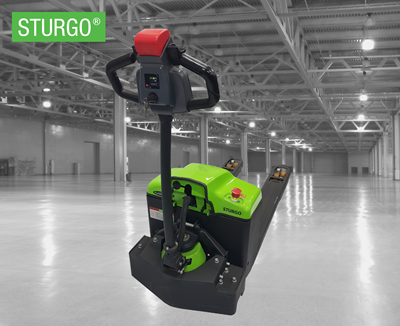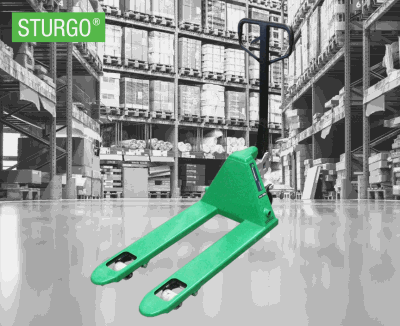![Manual vs. Electric Pallet Jacks – A Comprehensive Overview teaser]()
27 May 2020
What is a pallet jack?
In warehousing and factory settings, a pallet jack (also known as pump trucks or pallet trucks) are indispensable tools for moving and lifting wooden pallets from or into racks, on the stockroom floor, or other applications where bulky stock or items are placed on wooden pallets. Forks slot into the pallets and lift them off the ground for easier movement.
What types of Pallet Jacks are there?
Pallet jacks are manually operated or electrically powered using a motor. Though they may seem similar as they achieve similar results, there is more to consider when choosing a manual or electric pallet jack for your business.
What do you need to consider when choosing the right pallet jack?
Your operational needs will determine whether an electric or manual pallet jack is right for your business. This depends on the size and weight capabilities of the pallet jack, its operation environment, how far you are hauling pallets, and of course, your budget.
The first factor to consider is how much weight your typical load is and how bulky the loads might be. For standard size pallet jacks, there are a variety of options to choose from, both electric and manual. Fork widths can also vary – do you need a pallet jack for variable widths or just one? You need to make sure your pallet jack can carry the capacity with some overhead for extra safety.
Your operations environment may be indoor or outdoor; over clean and level floors or on softer terrain, even gravel – your pallet jack or pallet truck needs to be able to travel over the surfaces it will operate in most of the time.
The distance between trips is a big factor too. Manual pallet jacks might be better for shorter trips – about 10-15 metres or so. For trips over 20 metres to about 50 metres, electric pallet jacks are more effective.
Of course, your budget will determine whether you can afford a manual or electric pallet jack. Electric pallet jacks are more expensive but can be viewed as a long-term investment in productivity and more importantly, workplace health and safety. Manual pallet jacks require less maintenance but as mentioned, may cover less ground safely.
What are the applications of a pallet jack?
Both types of pallet jacks are indispensable in a warehouse or factory environment. They are lower-cost, easy to use tools that can complement or replace forklifts or lift trucks to move many types of wooden pallets around a factory or warehouse. Some pallet jacks can lift heavy loads into trucks or vehicles, including stacks of pallets. Some pallet jacks are configured to work with double-faced, or non-reversible pallets.
What are manual pallet jacks?
Manual pallet jacks are pallet jacks that are unpowered and must be pushed or pulled by an operator. The jack mechanism is manually handled into position through the handle.

Imaged: STURGO® All Terrain Electric Pallet Jack
Advantages of using manual pallet jacks
The advantage of manual pallet jacks is their price. They tend to be more affordable than their electric counterparts because they are simple to manufacture. They are also more accessible and easier to store than electric pallet jacks or trucks. They’re easier to make so they’re easy to maintain – they may not need any maintenance if used properly.
Drawbacks of using manual pallet jacks
Though all pallet jacks make lifting wooden pallet loads easier, there is an element of “brute force” required to operate a manual pallet jack. Because an employee must manually push or pull the loads, this can cause strains over time and have a greater risk of injury or accidents. They may also have to unnaturally bend, twist, or reach to use manual pallet jacks. One annoyance is that they’re used so often, employees will have a hard time finding them!
What are electric pallet jacks?
Electric pallet jacks are powered jacks that move using a motor and use hydraulics to lift wooden pallets and their loads.

Imaged: STURGO® Manual Pallet Jacks
Advantages of using electric pallet jacks
Electric pallet jacks or trucks are safer to use and create less stress and strains for users, as they do not have to manually push or pull the load on the jack. They are faster and can be used on a variety of unconventional or uneven surfaces. Electric jacks are also rated to carry heavier loads than manual pallet jacks.
Drawbacks of using electric pallet jacks
Though electric pallet jacks are easier and safer to use, they also require employees to be trained in their proper operation. Employees will also need to get ticketed or certified to use an electric pallet jack. If the ticketed employee is not on shift, this means a load may not be moved until they get back on the floor.
Since electric pallet jacks are complex machines, they require more maintenance. This could be on the motor, the chassis, the hydraulic lift, or even batteries. These parts and labour on the part of technicians can also be quite expensive. They are also bulkier and take up more space than manual pallet jacks.
Electric lifts also require fuel in the form of electricity, which means they may be out of action until they recharge. Finally, electric lifts due to their nature, are more expensive to purchase than manual pallet jacks.
See our range of pallet jacks and pallet trucks; both manual and electric
Backsafe Australia has a wide range of pallet jacks and pallet trucks in both manual and electric varieties suiting a range of operational requirements including high-lift scenarios. From standard, extra wide, and Chep pallets, our range of STURGO jacks are renowned for their reliability and safety. We also provide compact and full-featured STURGO electric pallet jacks with long drive time, high capacity, and innovative lithium technology. Get the best of both worlds with a semi-electric pallet jack which can handle up to 1.5 tonne loads.
Contact us by email or call us on 1300 305 314 to find out more.
Back To News Stories